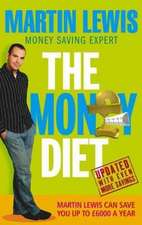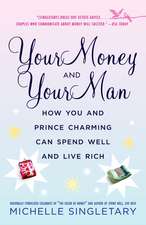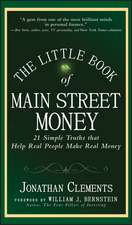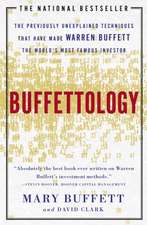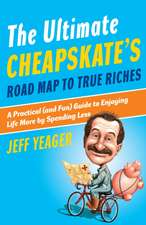The Wall Street Journal Complete Estate-Planning Guidebook
Autor Rachel Emma Silvermanen Limba Engleză Paperback – 31 aug 2011
Here, Wall Street Journal personal-finance reporter Rachel Emma Silverman walks you step-by-step through the process. Chock-full of clear and solid advice on how to get the most out of the main estate planning tools - including wills, trusts, life insurance, guardianship papers, and powers-of-attorney documents - the Wall Street Journal Complete Estate-Planning Guidebook will help make your estate-planning process as simple, smooth, and unintimidating as possible.
This book will help you:
· Clarify your estate-planning goals, such as dividing up property for heirs, reducing taxes or leaving money for charity
· Understand the key estate-planning documents you’ll need, including wills, beneficiary-designation forms, powers-of-attorney and health-care advance directives
· Decode the technical jargon that estate planners often use, so you feel comfortable discussing QTIPs and QPRTs when you sit down with your lawyer.
· Reduce possible estate, gift or generation-skipping taxes and legal and probate fees – decreasing what goes to the tax man and increasing what goes to your heirs
· Learn strategies to divide money and personal property among your heirs, and reduce the possibility of family fights
· Discuss sensitive estate-planning issues with your family
· Maintain your estate-plan over time, including how to store and when to update your documents
With completely up-to-date information on how to navigate the new 2011 estate tax legislation, and thoughtful advice on how to handle your estate in complicated situations – like if you’re single, in a same-sex relationship, or wish to provide for children with special needs - this is the estae-planning guide for today’s messy and complicated world.
One of the biggest estate planning mistakes people make, says Silverman, is waiting too long to start. Which is why the Wall Street Journal Complete Estate-Planning Guidebook isn’t just for those planning for retirement or their golden years. It’s for anyone, of any age, who wants the peace of mind of knowing that your wishes will be respected and your hard-earned money will get passed on as you would like.
Preț: 109.13 lei
Nou
Puncte Express: 164
Preț estimativ în valută:
20.88€ • 21.72$ • 17.24£
20.88€ • 21.72$ • 17.24£
Carte disponibilă
Livrare economică 24 martie-07 aprilie
Preluare comenzi: 021 569.72.76
Specificații
ISBN-13: 9780307461278
ISBN-10: 0307461270
Pagini: 208
Dimensiuni: 136 x 235 x 16 mm
Greutate: 0.29 kg
Ediția:New.
Editura: Crown Business
ISBN-10: 0307461270
Pagini: 208
Dimensiuni: 136 x 235 x 16 mm
Greutate: 0.29 kg
Ediția:New.
Editura: Crown Business
Notă biografică
Rachel Emma Silverman is an editor and reporter at the Wall Street Journal, where she has worked since 1998. She currently edits and co-writes The Juggle, the Wall Street Journal’s work-and-family website and reports on career, workplace and family issues. Before that, she covered personal finance, focusing on estate planning, wealth management, insurance, philanthropy, art and collectibles, and financial aspects of marriage and divorce. She graduated summa cum laude from Harvard University and was elected to Phi Beta Kappa. She now lives in Austin, TX with her husband and two young sons.
Extras
INTRODUCTION
You can’t avoid death or taxes.
But by carefully drafting your will and medical directives, and by having clear discussions with your family, you can reduce the chances that your relatives will squabble over your medical care or your heirlooms. And while few people are subject to the federal estate tax under the recently-passed tax law, if you’re one of them, you can use strategies such as trusts, life insurance and philanthropy to vastly reduce the amount of money that goes to the tax man and increase what goes to your heirs or the causes you believe in.
In The Wall Street Journal Complete Estate Planning Guidebook, I’ll take you through the estate-planning process, step-by-step -- from helping you figure out your planning goals (Benefiting your children? Minimizing estate taxes? Caring for Fido?) to helping you divvy up your family’s silver so your kids don’t fight over it.
The book is structured around the main estate planning tools you will likely encounter: wills, trusts, life insurance, guardianship papers, advance medical directives (which spell out your wishes in case you become severely incapacitated) and powers-of-attorney documents (which grant another person the power to make decisions about your medical care or finances when you cannot). I’ll also help you decode the technical jargon that estate planners often use, so you feel comfortable discussing QTIPs and QPRTs when you sit down with your lawyer.
Some situations require more complicated planning, so in special sections throughout the book, called “A Deeper Look,” we’ll talk about how to handle your estate if you’re single, in an unmarried or same-sex relationship, in a remarriage, or have a family member who is disabled or has special needs and you serve as a family caregiver. We’ll also address the growing “asset protection” industry, which seeks to shield estates from the hands of creditors or divorcing spouses. And since many of us are pet owners, we’ll discuss how to plan for our furry friends.
In the first chapter, Getting Started, we’ll cover key steps you should take before you and your lawyer draft your will, trust and other documents. Here, I will help you figure out your estate planning goals, take stock of your possessions, and provide strategies for talking these ideas over with your family. This chapter also offers guidance on how to choose a lawyer and other estate advisers. Clarifying your estate planning objectives, and discussing them with your family, will likely save you money and time—and minimize arguments—in the long run.
We’ll also provide information here about key estate planning steps to take at different stages in your life, and in a special section in this chapter, we’ll take a deeper look at estate-planning tactics if you’re single or in an unmarried or same-sex relationship.
Chapter Two, Death and Taxes, explains how estate, gift and generation-skipping taxes work and introduces some strategies to help minimize them. Under current law, these taxes affect just a small number of people, but it’s still important to understand how they work.
In Chapter Three, Wills, you’ll learn why a will is the centerpiece of most estate plans and we’ll go over some strategies to ensure that your money and belongings are left in the way that you choose. We’ll discuss how to choose an executor and I’ll explain the responsibilities of the role. We’ll also go over when it may make sense to say “no” to an inheritance. We’ll talk about how some estate plans may be equitable, but not necessarily equal—and I’ll offer some ideas about how to balance out bequests and gifts to heirs who may have very different economic and family circumstances.
While a will is an essential part of any estate plan, not all of your assets are governed by the terms of your will. In Chapter Four, Probate and Ways to Avoid It, I’ll explain how some key assets -- including retirement plans, insurance policies, certain jointly-owned property, and some trusts -- don’t pass through wills and aren’t subject to the legal process of probate. (Probate is a time-consuming court procedure that divides up your property as directed by your will.) I’ll help you make sure your property goes to your intended heirs. We’ll also talk about how to pass on Individual Retirement Accounts, or IRAs, which are subject to all sorts of complex rules.
Chapter Five, Trusts, discusses how trusts work. Contrary to popular belief, you don’t need to be a Rockefeller to create a trust. In fact, many people without significant wealth use trusts for a variety of reasons, such as avoiding the hassles and expense of probate or providing for young children. You’ll learn about the pros and cons of naming a family member or a financial services firm as your trustee and how to choose the right place to set up your trust. This chapter also includes a detailed “trust tip sheet,” that decodes the alphabet soup of trust lingo that you may hear from your lawyer. I’ll teach you how to structure trusts for minor children and spouses, how to create tax-saving trusts and how to pass your house on to heirs through a trust. In a special section in this chapter, we’ll take a deeper look at how to use trusts and other tactics to protect your assets from creditors and lawsuits.
In Chapter Six, Life Insurance, we’ll go over this valuable tool for providing for your family’s future. We’ll discuss the differences between term and permanent life insurance and how to best structure your life insurance policy to reduce estate taxes. And we’ll go over some basic insurance, tax and estate-planning strategies for passing on family businesses.
Chapter Seven, Philanthropy, discusses charitable giving, and how such generosity doesn’t just help important causes; it also can help you reduce taxes and provide for your family members. We’ll talk about different ways to make charitable gifts, including direct bequests and charitable trusts, and I’ll explain the pros and cons of setting up your own charitable foundation.
In Chapter Eight, Preparing for the Unthinkable, we’ll discuss other key estate-planning documents you’ll need. These include papers naming a guardian for your children, as well as powers of attorney for finances and health, crucial documents which name agents to make financial and medical decisions for you if you’re unable to do so yourself. In a section in this chapter, we’ll take a deeper look at planning for family members with special needs. We’ll also talk about making funeral and burial plans. And we’ll address how to plan for your pets’ care when you are not around.
In Chapter Nine: Preserving Family Harmony, we’ll go over some ways to help strengthen your estate plans to help prevent family feuds and challenges, especially when you’re no longer around to voice your wishes. Here, we’ll talk about feud de-fusers such as mediation, arbitration and “no-contest” clauses, which disinherit heirs if they protest your will. We’ll address some estate planning strategies for blended families who are in second and third marriages and may have both children and stepchildren. I’ll give you ideas for dividing up personal property, such as jewelry and heirlooms. That tangible stuff with sentimental value often causes more rifts than cash. And we’ll take a deeper look at an unusual, but effective way, to help keep family harmony: paying family members for their caregiving contributions if you or your spouse were to become incapacitated.
At this point you’ll have learned how to draw up your will, trust and other estate documents. Congratulations! But you’re not quite done yet. You still need to create a system for taking care of your estate plan over time. That’s where Chapter Ten: Maintaining Your Plan, comes in. We’ll go over the “care and feeding” of your estate plan – how to store it and when to update it, and the importance of keeping your plans flexible.
In short, this book should provide you with the information you need to ensure that when you’re gone, your hard-earned money goes where you want it to. That said, if your finances or family situations are unusually complex or your spouse or heirs are non-U.S. citizens, I highly recommend also getting tailor-made legal and tax advice from qualified advisers who specialize in estate planning.
The more you plan ahead, the lower the chances of divisive family brawls and surprise tax bills. What’s more, when you educate yourself about estate planning, you can reduce the number of expensive hours you spend with your lawyer and avoid sketchy tax-shelters and other shams.
As you work through the Wall Street Journal Complete Estate-Planning Guidebook, rest assured that although you can’t evade death or taxes, you can create an estate plan that will make both a whole lot easier for your loved ones. Your family will thank you for it.
You can’t avoid death or taxes.
But by carefully drafting your will and medical directives, and by having clear discussions with your family, you can reduce the chances that your relatives will squabble over your medical care or your heirlooms. And while few people are subject to the federal estate tax under the recently-passed tax law, if you’re one of them, you can use strategies such as trusts, life insurance and philanthropy to vastly reduce the amount of money that goes to the tax man and increase what goes to your heirs or the causes you believe in.
In The Wall Street Journal Complete Estate Planning Guidebook, I’ll take you through the estate-planning process, step-by-step -- from helping you figure out your planning goals (Benefiting your children? Minimizing estate taxes? Caring for Fido?) to helping you divvy up your family’s silver so your kids don’t fight over it.
The book is structured around the main estate planning tools you will likely encounter: wills, trusts, life insurance, guardianship papers, advance medical directives (which spell out your wishes in case you become severely incapacitated) and powers-of-attorney documents (which grant another person the power to make decisions about your medical care or finances when you cannot). I’ll also help you decode the technical jargon that estate planners often use, so you feel comfortable discussing QTIPs and QPRTs when you sit down with your lawyer.
Some situations require more complicated planning, so in special sections throughout the book, called “A Deeper Look,” we’ll talk about how to handle your estate if you’re single, in an unmarried or same-sex relationship, in a remarriage, or have a family member who is disabled or has special needs and you serve as a family caregiver. We’ll also address the growing “asset protection” industry, which seeks to shield estates from the hands of creditors or divorcing spouses. And since many of us are pet owners, we’ll discuss how to plan for our furry friends.
In the first chapter, Getting Started, we’ll cover key steps you should take before you and your lawyer draft your will, trust and other documents. Here, I will help you figure out your estate planning goals, take stock of your possessions, and provide strategies for talking these ideas over with your family. This chapter also offers guidance on how to choose a lawyer and other estate advisers. Clarifying your estate planning objectives, and discussing them with your family, will likely save you money and time—and minimize arguments—in the long run.
We’ll also provide information here about key estate planning steps to take at different stages in your life, and in a special section in this chapter, we’ll take a deeper look at estate-planning tactics if you’re single or in an unmarried or same-sex relationship.
Chapter Two, Death and Taxes, explains how estate, gift and generation-skipping taxes work and introduces some strategies to help minimize them. Under current law, these taxes affect just a small number of people, but it’s still important to understand how they work.
In Chapter Three, Wills, you’ll learn why a will is the centerpiece of most estate plans and we’ll go over some strategies to ensure that your money and belongings are left in the way that you choose. We’ll discuss how to choose an executor and I’ll explain the responsibilities of the role. We’ll also go over when it may make sense to say “no” to an inheritance. We’ll talk about how some estate plans may be equitable, but not necessarily equal—and I’ll offer some ideas about how to balance out bequests and gifts to heirs who may have very different economic and family circumstances.
While a will is an essential part of any estate plan, not all of your assets are governed by the terms of your will. In Chapter Four, Probate and Ways to Avoid It, I’ll explain how some key assets -- including retirement plans, insurance policies, certain jointly-owned property, and some trusts -- don’t pass through wills and aren’t subject to the legal process of probate. (Probate is a time-consuming court procedure that divides up your property as directed by your will.) I’ll help you make sure your property goes to your intended heirs. We’ll also talk about how to pass on Individual Retirement Accounts, or IRAs, which are subject to all sorts of complex rules.
Chapter Five, Trusts, discusses how trusts work. Contrary to popular belief, you don’t need to be a Rockefeller to create a trust. In fact, many people without significant wealth use trusts for a variety of reasons, such as avoiding the hassles and expense of probate or providing for young children. You’ll learn about the pros and cons of naming a family member or a financial services firm as your trustee and how to choose the right place to set up your trust. This chapter also includes a detailed “trust tip sheet,” that decodes the alphabet soup of trust lingo that you may hear from your lawyer. I’ll teach you how to structure trusts for minor children and spouses, how to create tax-saving trusts and how to pass your house on to heirs through a trust. In a special section in this chapter, we’ll take a deeper look at how to use trusts and other tactics to protect your assets from creditors and lawsuits.
In Chapter Six, Life Insurance, we’ll go over this valuable tool for providing for your family’s future. We’ll discuss the differences between term and permanent life insurance and how to best structure your life insurance policy to reduce estate taxes. And we’ll go over some basic insurance, tax and estate-planning strategies for passing on family businesses.
Chapter Seven, Philanthropy, discusses charitable giving, and how such generosity doesn’t just help important causes; it also can help you reduce taxes and provide for your family members. We’ll talk about different ways to make charitable gifts, including direct bequests and charitable trusts, and I’ll explain the pros and cons of setting up your own charitable foundation.
In Chapter Eight, Preparing for the Unthinkable, we’ll discuss other key estate-planning documents you’ll need. These include papers naming a guardian for your children, as well as powers of attorney for finances and health, crucial documents which name agents to make financial and medical decisions for you if you’re unable to do so yourself. In a section in this chapter, we’ll take a deeper look at planning for family members with special needs. We’ll also talk about making funeral and burial plans. And we’ll address how to plan for your pets’ care when you are not around.
In Chapter Nine: Preserving Family Harmony, we’ll go over some ways to help strengthen your estate plans to help prevent family feuds and challenges, especially when you’re no longer around to voice your wishes. Here, we’ll talk about feud de-fusers such as mediation, arbitration and “no-contest” clauses, which disinherit heirs if they protest your will. We’ll address some estate planning strategies for blended families who are in second and third marriages and may have both children and stepchildren. I’ll give you ideas for dividing up personal property, such as jewelry and heirlooms. That tangible stuff with sentimental value often causes more rifts than cash. And we’ll take a deeper look at an unusual, but effective way, to help keep family harmony: paying family members for their caregiving contributions if you or your spouse were to become incapacitated.
At this point you’ll have learned how to draw up your will, trust and other estate documents. Congratulations! But you’re not quite done yet. You still need to create a system for taking care of your estate plan over time. That’s where Chapter Ten: Maintaining Your Plan, comes in. We’ll go over the “care and feeding” of your estate plan – how to store it and when to update it, and the importance of keeping your plans flexible.
In short, this book should provide you with the information you need to ensure that when you’re gone, your hard-earned money goes where you want it to. That said, if your finances or family situations are unusually complex or your spouse or heirs are non-U.S. citizens, I highly recommend also getting tailor-made legal and tax advice from qualified advisers who specialize in estate planning.
The more you plan ahead, the lower the chances of divisive family brawls and surprise tax bills. What’s more, when you educate yourself about estate planning, you can reduce the number of expensive hours you spend with your lawyer and avoid sketchy tax-shelters and other shams.
As you work through the Wall Street Journal Complete Estate-Planning Guidebook, rest assured that although you can’t evade death or taxes, you can create an estate plan that will make both a whole lot easier for your loved ones. Your family will thank you for it.


